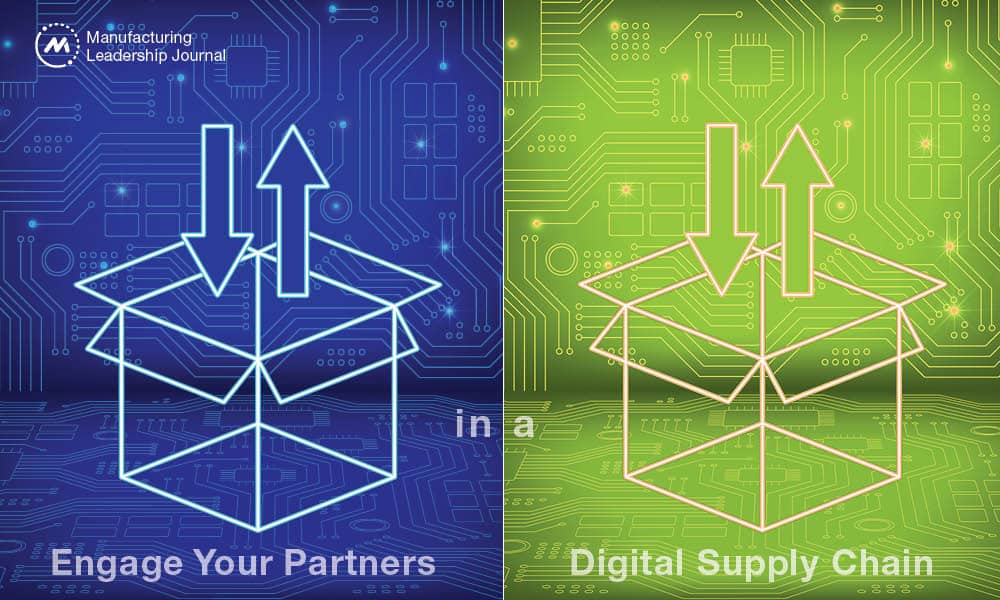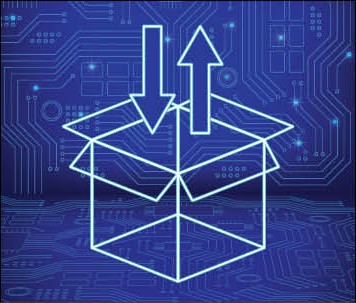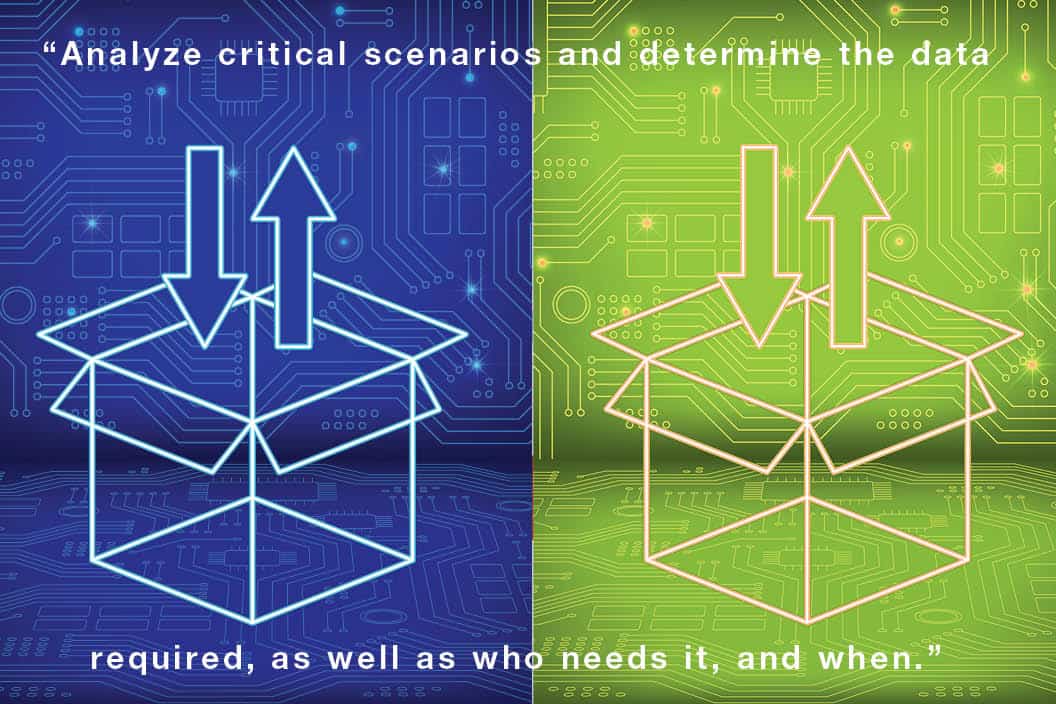Congratulations to the 2022 Manufacturing Leadership Award Winners
Manufacturing Leadership Journal content and MLC resources are exclusively available to MLC members. Please sign up for an account or log in to view this content.
Engage Your Partners in a Digital Supply Chain
How manufacturers can help smaller supply chain partners embrace the changes needed for a successful digital supply chain.

How manufacturers can help smaller supply chain partners embrace the changes needed for a successful digital supply chain.

On a recent Manufacturing Leadership Council (MLC) call, member participants discussed their most pressing issues and priorities for supply networks in 2022. Strategies for helping smaller supply chain partners to embrace digitization wasn’t one of the top five topics ranked (it was slotted eighth), but it consumed a good part of the discussion. This wasn’t a surprise. It’s consistent with what we’re hearing from many of our manufacturing clients: Lack of digitization in the supply chain is hampering visibility and agility.
Increasing visibility into the supply chain was already a priority for manufacturers of all sizes before the pandemic, but it’s now become critical given the levels of volatility, instability, and unpredictability. In a Gartner study, 80% of respondents said they have insufficient supply chain visibility.
Pandemic May End, Instability Will Remain
We believe the supply chain issues brought on by the pandemic and recent geopolitical events will persist for some time. Companies that were in a steady state a year ago are seeing new challenges emerge.
Consider the example of a contract manufacturer that produces and packages beverages. The company’s customer buys packaging materials, orchestrates the logistics, and sends the materials. The company suddenly found it was having issues getting raw materials for cans on time. The materials were coming from a new supplier. While the raw material was in spec when the manufacturer put the material through its process, it found cans were tipping over due to small variances for which their machines were not optimized. This caused significant downtime. If the manufacturer had better visibility into its supply chain, it could plan better for the changes by qualifying the new cans and optimizing machine settings ahead of planned production runs. But because of the nature of the relationship, the contract manufacturer was in the dark. Many other manufacturers have similar stories.
Even when things do stabilize, there will continue to be new and unexpected challenges. Agility and resiliency will be key to reacting quickly: rerouting orders, developing distribution center bypass programs with high-volume customers, or switching plants or lines within the four walls of an existing plant, for instance. Consumer and industrial brand owners and their suppliers and other supply chain partners will need to advance digital capabilities to increase visibility and, thus, agility.
Brand Owners Must Take the Initiative
Many larger manufacturers are already on the journey toward developing a digital supply chain, but their Tier 1, 2, and 3 suppliers are medium-sized to smaller companies that may be in the early stages of embracing smart, digital technology — or have not even begun. When smaller suppliers do not have the technical footprint to manage data or enable the necessary interfaces — for example, APIs between ERPs or EDI between logistics partners, customers, and manufacturers — the relationship must rely on spreadsheets and manual processes, such as on-the-water reports. Manual processes are not just slower, but also prone to errors. In a survey conducted by Supply Chain Dive and West Monroe, nearly 75% of manufacturing and distribution executives said they are primarily using Microsoft Excel in their S&OP processes.

“The more mature trading partner needs to set the example and take the reins.”
Manufacturers whose efforts to increase supply chain visibility are limited by suppliers’ lack of digitization need to be proactive in guiding their suppliers — particularly smaller ones — toward M4.0 and digital transformation. In other words, the more mature trading partner needs to set the example and take the reins. If you are in this situation, what should you be thinking about? And what steps should you take?
What Good Supply Chain Visibility Looks Like
Ideally, a brand owner should have insight into key supply elements up and down the supply chain, including product development through sourcing, assembly, distribution, and logistics to the point of consumption. The seed of visibility starts with validated and released technical specifications for raw materials or subassembly components. Once validated and released, these should accompany the product through the supply chain because these technical specs are needed by multiple stakeholders: manufacturing, purchasing, warehousing, logistics, customers, regulators, and others.
Having common data enables an OEM and Tier 1 (and lower) suppliers to get ahead of potential specification or supply disruptions. For example, if a component will run out of supply in four weeks, the OEM can work with the supplier to find an appropriate substitute. Automotive manufacturing has had full supply chain visibility for several decades. Complete traceability back to the IGES file on the CAD tube allows OEMs to make last-minute engineering changes to prevent line stoppages — coordinating among purchasing, supplier, and logistics providers to time the change so it cuts into the manufacturing line on a specific date and shift.
Typically, the key to this level of visibility is extending the OEM’s ERP to the supply base and logistics partners through an Esker or Infor Nexus or similar P2P tool. The relatively simple act of presenting purchase orders for acceptance and editing through a browser can go a long way toward improving inbound visibility to raw materials or finished goods.
Understandably, the operating model will influence visibility and data needs. Some models present more risk of flying blind. For example, if a Tier 1 supplier manages other tiers below it, then there may not be visibility into or control of those tiers. If an OEM uses a nominated supplier list only, then there may not be adequate visibility into prices paid or rebate arrangements between suppliers. In such cases, emerging technology such as blockchain may allow the OEM to monitor such transactions. Another common practice is an invoice audit system to confirm process paid and rebates taken — assuming suppliers are willing to provide this level of transparency.
Why Aren’t Companies Farther Along?
The concept of a digital supply chain is still nebulous and means different things to different people. As a result, many manufacturers may not have a clear vision. When there isn’t a clear target, it’s easier to defer action.
Securing resources is a challenge — especially now. Developing better visibility across the supply chain requires investment in people, dollars, and time. But many organizations are still buried in the rubble of issues brought on by the pandemic. Some have taken action in fits and starts, but the volatility of the past two years has prevented sustained progress. Others have had to defer investments altogether due to the uncertainty of the market.

“If the goal is to become digital, you need to solve analog problems with a digital mindset.”
There is also the issue of trust. Partners must have confidence in each other’s security capabilities and a willingness to connect systems in a world where cybersecurity risks are growing at an exponential rate. Ransomware incidents are proliferating, particularly in manufacturing. In West Monroe’s third-quarter 2021 executive poll, cyberattacks represented the second-largest threat to conducting business, behind only hiring and retention of workforce.
Guiding Suppliers Toward a Digital Supply Chain
Although your approach will depend on your specific operating model and business needs, we believe there are some common denominators that apply in most situations. Some of these are low-cost or no-cost initiatives that can help you build traction, which can be especially valuable given the challenges involved with securing new technology investments.
Start with what you can control. If your backyard isn’t in order, then why reach over into the neighbor’s yard? Assess your supply chain processes to understand where you can drive improvement. An assessment should look for gaps in technology, processes, and people, and also measure the maturity of key capabilities that you need to be able to use data from your supply chain to make decisions. This should provide clarity around the most critical next steps and highlight the particular areas of the supply chain — and particular suppliers — where you should focus to increase collaboration, automation, and visibility.
Make this a multidisciplinary initiative. Increasing supply chain visibility is a complex effort that impacts and/or requires the participation of multiple functions, including procurement, finance, inventory management, distribution, production, sales, marketing, information technology, and more. A multidisciplinary team with representation from key functions and a clear mandate will make greater progress than an individual function trying to tackle this on its own.
Like any digital initiative, this will require skills in supply chain management, operations, inventory optimization, organizational resilience, data analytics, software development, and risk management. As you ramp up, focus on filling any key skill gaps necessary to establish an effective program for working with smaller suppliers to increase visibility.
Clarify what good visibility means for your organization. Analyze critical scenarios and determine the data required, as well as who needs it, and when. To participate in a digital supply chain, it is important to understand what data needs to be shared with customers and vendors and what data, in return, you need access to. For example, receiving up-to-date lead times on a specific part can be ingested into a production scheduling system to make necessary updates to the schedule which could trigger communication to the customer with updated delivery dates. Another example is receiving accurate inbound logistics estimated arrival (at port) times via EDI connections to vessel operators or freight forwarders.

Develop baseline metrics such as critical component lead times, days of supply, or quality conformance to inform stakeholders, enable goal setting and agile decision-making. Where possible, try to measure supply chain processes as a whole with suppliers and customers and not just as an individual company or buyer. This, of course, assumes some level of interconnectivity across the entire supply chain.
Engage your supply partners. If the goal is to become digital, you need to solve analog problems with a digital mindset. That starts with focusing on the end user, business stakeholders, and supply partners, and working to solve the problem from their perspectives.
Dialogue is key to increasing supply chain visibility, and the good news is that doesn’t require (much) investment. Establish monthly meetings with a clear agenda around goals and setting the strategy for sharing data. Start by understanding what is important to each party and plans for focus over the coming year. This discussion should work toward establishing data standards and governance — including the types of data that will and will not be shared and how that will happen.
Once a good dialogue has been established, this can proceed to an assessment of what is required to achieve the desired level of integration. A simple SWOT analysis may suffice, or in more complex relationships, it may be necessary to dedicate resources to dig into the issues and opportunities. This will involve detailed discussion around master data, APIs, EDI, integrations across multiple applications, and middleware layers and how exceptions are managed. These are essential points to making supply chain visibility happen.

“There is no going back to normal. There is only now, and managing in the now requires agility.”
Digital leaders also move fast — they fail fast, learn, adapt, and iterate. This is an area where it can be very helpful to start with a pilot program that allows you to test approaches, assess the results, see what works, and then expand effective practices.
Once the program is moving on multiple dimensions, it may be helpful to have a program management office that can manage the process of building integration capabilities relevant to various supply partners. As you implement changes, measure the ongoing output and use that insight to make additional improvements.
Determine the right supporting technology. Automation will be key to increasing supply chain visibility — and this will require investment. The good news is that today’s companies have access to increasingly effective technologies, and broader choices. Step one in this process is to understand those capabilities and how leading organizations are using them to increase visibility into their supply network.
Be prepared to facilitate the discussion around evaluating and selecting the right tools and applications to enable integration, particularly when working with smaller and less technology-enabled supply chain partners. Surviving the next significant supply chain disruption will require a level of flexibility that organizations cannot achieve with complex spreadsheet formulas. So, consider where you can use automation to share the necessary data and remove reliance on spreadsheets, particularly upstream where master data and feeder data originate. One common solution is to extend ERP access to partners so they can fill in data. Robotic process automation can also serve as a stop-gap measure or enhancement to existing manual processes for updating milestones.

“This is a journey, and the sooner you start, the sooner you will see results.”
Additionally, consider whether or how cost-sharing may be possible. For example, can one business provide market insight for all parties involved? This can help address some of the financial constraints of smaller suppliers.
Integrated operations management (IOM). It is important to look at how information flows within and between companies. The right people need to have the right information and conversations at the right time to effectively manage the business. Look at this holistically to ensure comprehensive long-, medium-, and short-range planning occurs. Ensure controls are in place to monitor the execution of processes and catch small problems before they grow. Most importantly, ensure data is integrated and behaviors are developed to review performance, action variance, and drive continuous improvement. Taking this action across supply chain participants extends transparency in the direction of the customer with better, faster updates related to completion dates and estimated deliver schedules to enhance service.
If you are a supply partner, what can you do? Foremost, be open to dialog with your OEM customer(s) and collaborate, collaborate, collaborate! But you don’t need to wait for a larger customer’s project to get going. Start with your own processes and suppliers first, and then think about managing upwards.
Manage for Now
As far as the pandemic and geopolitics are concerned, we are not out of the woods yet. Also, it is likely the structural changes brought on by the pandemic and other disruptive events over the past few years will be here to stay. There is no going back to normal. There is only now, and managing in the now requires agility. In our view, supply chains cannot be agile without being digital. Manufacturers need to stop deferring the need to be digital. Starting to tackle the transparency issue will drive tangible progress. There are steps you can take now — described above — but, you will eventually need to make some necessary investments to develop the level of visibility and transparency that creates an agile, resilient supply chain. This is a journey, and the sooner you start, the sooner you will see results. M
About the authors:

David McGraw is Senior Manager, Consumer & Industrial Products.

Kris Slozak is Senior Principal, Consumer & Industrial Products

Tim Vadney is Director, Operations Excellence, with West Monroe

The fact that supply chain disruption made major news at the onset of the pandemic crisis in the United States shows the depth of its severity. “When the president or any global leader talks about the supply chain, that is not a good thing!” said Simon Ellis, VP of Supply Chain Strategies at IDC.
Ellis and Bart Talloen, VP of Supply Chain Innovation and Insights at Johnson & Johnson, took part as panelists on “The Implications”, an edition of the Manufacturing Leadership Council’s What’s Next for Manufacturing? virtual meeting series, which took place July 21. Based on the theme of the June Manufacturing Leadership Journal, this meeting was focused on supply chain impacts and future implications.
While today’s supply chains have better visibility and resilience than ever before, Ellis says they still aren’t resilient enough. Understanding the multidimensional nature of risk and creating a resilient supply chain is essential to minimizing risk, especially when disruptions seem poised to occur more frequently and with greater severity.
Looking into the future, Ellis says that while some elements of the supply chain will resolve themselves over the summer, it’s probable that demand shocks will persist. While it’s unlikely that most companies will undertake massive reshoring of their operations, it is likely they will re-examine where their goods and materials are produced and make changes that strategically prioritize resilience over cost savings.
Ellis identified five technologies that can help enable a more resilient supply chain:
- Cloud delivery/SAAS applications
- Control tower/digital twin
- Scalable data and analytics capabilities that inform real-time decision making
- Artificial intelligence and machine learning
- Multi-enterprise networks
For Johnson & Johnson, the top priority as the pandemic grew was to ramp up holistic multi-faceted risk management and supporting business continuity plans. From an end-to-end supply chain orchestration perspective, improving demand sensing and agile response to it and building supply chain resilience was key. With four facilities achieving the status of World Economic Forum Lighthouse Factories, the new demands brought about by COVID-19 were met by the company’s ongoing digital journey to bring together its existing innovation solutions into one integrated platform that could allow for end-to-end visibility throughout a digital ecosystem.
To meet intense changes in demand, J&J relied on a suite advanced M4.0 technologies to enable agility and flexibility. That included increasing the visibility of real-time data to make quick decisions. The company deployed AR on the factory floor and in warehouse and distribution centers for remote maintenance and engineering support as well as instructions and training. Other factory technologies were accelerated, such as advanced automation and robotics to help frontline workers and address staffing constraints. Also, 3D printing technology has been applied within J&J operations and outside in hospital systems, in support of the broader COVID response efforts (ventilators, masks etc.).
Talloen also shared an advanced example from J&J’s manufacturing operations called the MoBot, or Mobile Robot. These MoBots are standardized, stand-alone independent units (modules) that execute a single manufacturing or warehouse activity. They can be configured into integrated flexible, modular, and mobile manufacturing or supply systems. The MoBots use AI technology and have the ability to be reprogramed based on need in an easily reconfigurable production or warehouse line. J&J is deploying this approach in its pharmaceutical, consumer healthcare, medical devices, and over-the-counter drug manufacturing.
Asked for his feeling on whether complex global supply chains will give way to shorter regional ones, Talloen believes those changes will happen on a case-by-case basis. At J&J, the company is continuing to pursue its journey toward greater agility and customization, but it’s not one-size-fits-all. He believes that many companies may well now re-evaluate their suppliers and supply chain footprint as they identify specific areas of vulnerabilities and risk. The future will be about agility, adaptability and resiliency.
Supply chain risk is likely to remain a hot topic for at least the rest of the year as manufacturers reassess their operations, vendors, suppliers, logistics networks, and more. With no vaccine imminent and many parts of the United States currently affected by their own outbreaks, it’s likely that supply chain stability will be elusive for some time to come.
Recordings of all four What’s Next for Manufacturing? virtual meetings are now available on demand at: www.manufacturingleadershipcouncil.com/kbtopic/covid-19-resources/
Henry Stueber, Senior VP at Greene Tweed, believes today’s opportunities for manufacturing transformation represent one of the most energizing times in industrial history.
Q: What is your role and focus?
A: I am responsible for a variety of functions, including manufacturing, platform management, business development, advanced technology (R&D), projects, supply chain, marketing, quality, and process engineering. My focus is maneuvering the organization through transformation and unprecedented growth.
Q: What is the most pressing issue facing the manufacturing industry today?
A: Blending the knowledge from current successful leaders with the new skills emerging from talent that will take companies into Industry 4.0. Many senior leaders have been successful utilizing skills that fit the situation at the time. A new set of employees are entering the workforce that dissect data and disseminate information much faster. Blending the skills of the past with the speed of now, a new style work-force will emerge.
Q: What is the most important corporate initiative?
A: Factory Innovation and Technology Transformation – an initiative we call The Right FITT™. This new initiative is a five-year manufacturing strategy in line with Industry 4.0 technology and best practices. Our goal is to refocus and retool operations to better support a growing customer base and our employees as we look forward to the future.
Q: What will be the most important leadership qualities to possess in the future?
A: Urgency, accountability, and simplification, all driven by a never ending desire to learn and improve the world around you; this includes developing the next generation of leaders.
Q: What will be the greatest opportunities for manufacturers over the next five years?
A: The opportunity to transform the way we work is exciting and energizing. Major manufacturing changes are underway for only the fourth time in history. We are all fortunate to be part of this current transformation where we have the opportunity to reinvent ourselves, and our work. This transformation should energize us all.
Q: What is your favorite activity outside of work or the last book you read?
A: As a retired U.S. Naval officer, I enjoy taking time at the beach being with my family looking over the ocean. I have also enjoyed playing golf since an early age. Most recent impactful books are New Product Blueprinting by Dan Adams, Not Impossible by Mick Ebeling, and Turn the Ship Around by L. David Marquet.
Henry Stueber
Company: Greene Tweed
Location: Kulpsville, PA
Industry: Perfluoroelastomers, Thermoplastics, and Thermoplastic Composites
Website: http:// www.gtweed.com
/
Winnebago VP Chris West believes manufacturing leaders must close the gaps that prevent their teams from being engaged and empowered.
Q: What is your role and focus at your company?
A: I am Vice President of Operations for Winnebago Industries. Winnebago Industries has multiple facilities in Iowa, Indiana, Oregon, Minnesota and Florida and is a leading U.S. manufacturer of outdoor lifestyle products under the Winnebago, Grand Design and Chris-Craft brands. We build the highest quality motorhomes, travel trailers, fifth wheel products and boats, which are used primarily in leisure travel and outdoor recreation activities.
Q: What is the most pressing issue facing the manufacturing industry today?
A: Obviously, there are always issues to face. Our current priority is addressing the shrinking amount of talent and skills available for our operations. We see this as a key issue we must address now, and in the future, so we’re actively working on strategies and partnerships to address this in our local communities.
Q: What is the most important corporate initiative?
A: We are a growing business that has doubled in 24 months and there are many challenges an organization faces with that type of growth. In order to grow, our business has to be scalable and we are in the process of implementing a new ERP system which is being strategically configured to not only support who we are today, but also to position us for who we aspire to be in the future.
Q: What will be the most important leadership qualities to possess in the future?
A: It is difficult to pinpoint a single most important leadership quality anyone must have, but we know that people often leave bosses not companies. I believe it is most important for leaders to recognize this and be people leaders who positively influence the lives of their teams and communities. By understanding the gaps preventing your teams from being engaged and empowered, you can evolve as a leader to close those gaps and unleash untapped potential. We believe you win with talent, and we must attract and retain that talent to win in the long run.
Q: What will be the greatest opportunities for manufacturers over the next five years?
A: I believe the greatest opportunity is being able to develop, implement, and leverage Industry 4.0. These trends in manufacturing technology are moving fast and manufacturers who are not taking the time to understand them and strategize on how they can, and will, create value for their businesses will be left behind.
Q: What is your favorite activity outside of work or the last book you read?
A: I’m an avid runner. I enjoy the peacefulness and solitude of running. It clears my mind and allows me opportunities to focus on specific problems I may be dealing with.
Chris West
Company: Winnebago Industries
Location: Forest City, Iowa
Size: $2 Billion Revenues (2018); 2,850 Employees
Industry: Recreational Vehicles, Marine
Website: http:// www.winnebagoind.com
Whirlpool VP Dale Laws feels clarity of purpose is essential for M4.0 leaders.
Q: What is your role and focus at your company?
A: I am Vice President of Manufacturing Operations for Whirlpool Corporation’s North American Laundry and Dishwasher facilities. We’re the world’s leading major home appliance company with 14 manufacturing operations in the North American Region (NAR). My focus is delivering our goals and objectives at four of our manufacturing operations and actively supporting the execution of our broader strategy across the NAR manufacturing enterprise.
Q: What is the most pressing issue facing the manufacturing industry today?
A: It’s an exciting time in manufacturing. We’re seeing advances in automation and robotics that are making these technologies more cost effective. Sensors, computing power and software advances are making true connectivity possible. All of these are coming together to allow us to produce and operate in new and creative ways. The issue is that the talent and skills to integrate these and other technologies into our operations, maintain them, and use the data to best advantage, is in very limited supply. I believe this will be a challenge for many years to come.
Q: What is the most important corporate initiative?
A: From a manufacturing perspective, our primary objective is to deliver our Manufacturing 2020 Strategy. This is globally aligned and the focus of all of our manufacturing operations around the world. It consists of six focused work streams ranging from infrastructure changes, to leveraging technology, i.e., Industry 4.0.
Q: What will be the most important leadership qualities to possess in the future?
A: Clarity of purpose. I may be a little old school with this one, but I consider some leadership traits to be fundamental and timeless. The pace of change continues to accelerate and does play a role in how I think about leadership. However, to me, this acceleration of change means that clarity of purpose is more important than ever. True alignment means questions can be answered faster at all levels of the organization. It can also be very engaging, motivating, and freeing for your team. They don’t have to wonder where we are going, or what success looks like, if you’ve clearly defined it for them.
Q: What will be the greatest opportunities for manufacturers over the next five years?
A: It’s Industry 4.0 and the connected factory. Most manufacturers are working diligently to understand how to leverage technology to drive additional value. However, we are still just scratching the surface. We are still early in our journey. What happens next? Perhaps, it’s the connected value stream. I believe the closer we get these connections to the customer, the more opportunity and value there will be.
Q: What is your favorite activity outside of work or the last book you read?
A: I tend to gravitate to those that involve things that are motorized, such as dirt bikes, cars, and flying powered paragliders.
Dale Laws
Company: Whirlpool Corporation
Location: Benton Harbor, MI
Size: $21 Billion annual revenues; 92,000 employees
Industry: Home appliances
Website: http:// www.whirlpoolcorp.com
/